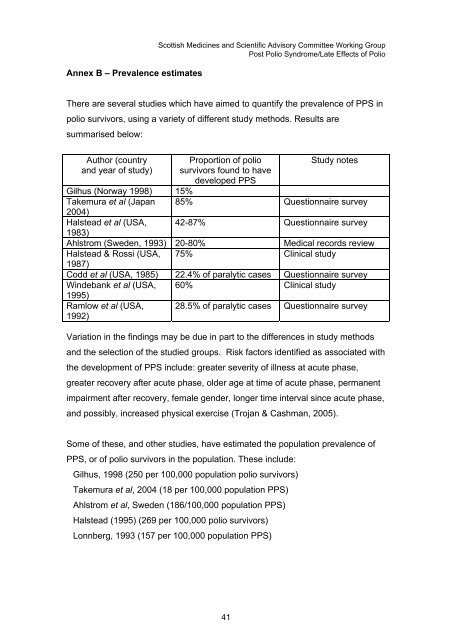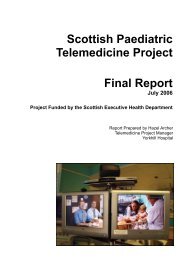SMASAC Working Group Post Polio Syndrome - Scottish Health On ...
SMASAC Working Group Post Polio Syndrome - Scottish Health On ...
SMASAC Working Group Post Polio Syndrome - Scottish Health On ...
Create successful ePaper yourself
Turn your PDF publications into a flip-book with our unique Google optimized e-Paper software.
Annex B – Prevalence estimates<br />
<strong>Scottish</strong> Medicines and Scientific Advisory Committee <strong>Working</strong> <strong>Group</strong><br />
<strong>Post</strong> <strong>Polio</strong> <strong>Syndrome</strong>/Late Effects of <strong>Polio</strong><br />
There are several studies which have aimed to quantify the prevalence of PPS in<br />
polio survivors, using a variety of different study methods. Results are<br />
summarised below:<br />
Author (country<br />
and year of study)<br />
Proportion of polio<br />
survivors found to have<br />
developed PPS<br />
Study notes<br />
Gilhus (Norway 1998) 15%<br />
Takemura et al (Japan<br />
2004)<br />
85% Questionnaire survey<br />
Halstead et al (USA,<br />
1983)<br />
42-87% Questionnaire survey<br />
Ahlstrom (Sweden, 1993) 20-80% Medical records review<br />
Halstead & Rossi (USA,<br />
1987)<br />
75% Clinical study<br />
Codd et al (USA, 1985) 22.4% of paralytic cases Questionnaire survey<br />
Windebank et al (USA,<br />
1995)<br />
60% Clinical study<br />
Ramlow et al (USA,<br />
1992)<br />
28.5% of paralytic cases Questionnaire survey<br />
Variation in the findings may be due in part to the differences in study methods<br />
and the selection of the studied groups. Risk factors identified as associated with<br />
the development of PPS include: greater severity of illness at acute phase,<br />
greater recovery after acute phase, older age at time of acute phase, permanent<br />
impairment after recovery, female gender, longer time interval since acute phase,<br />
and possibly, increased physical exercise (Trojan & Cashman, 2005).<br />
Some of these, and other studies, have estimated the population prevalence of<br />
PPS, or of polio survivors in the population. These include:<br />
Gilhus, 1998 (250 per 100,000 population polio survivors)<br />
Takemura et al, 2004 (18 per 100,000 population PPS)<br />
Ahlstrom et al, Sweden (186/100,000 population PPS)<br />
Halstead (1995) (269 per 100,000 polio survivors)<br />
Lonnberg, 1993 (157 per 100,000 population PPS)<br />
41



